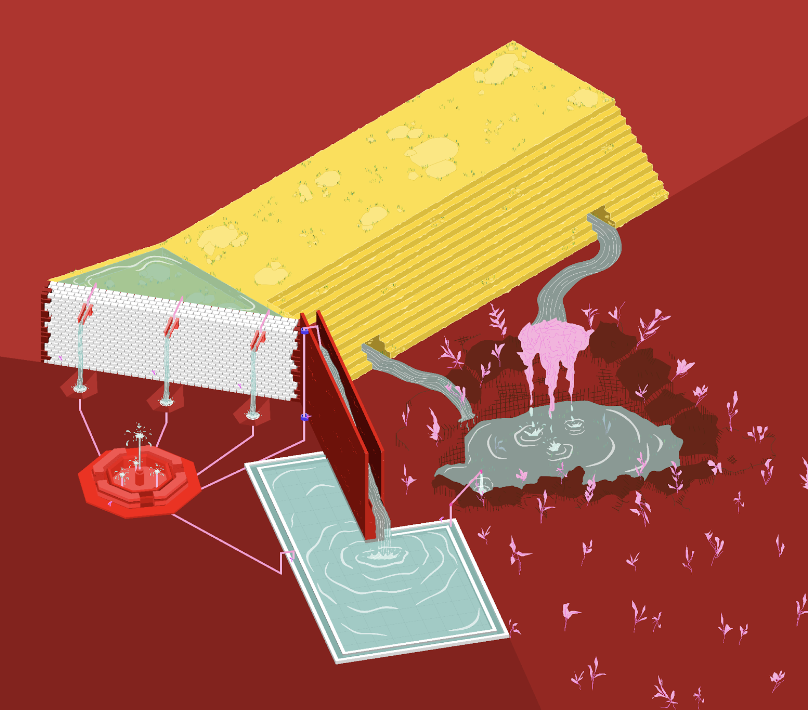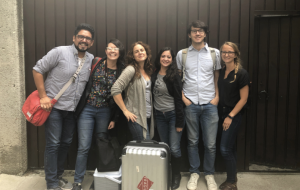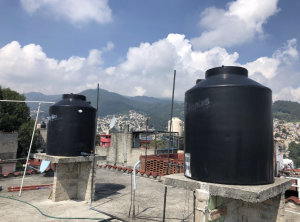How Households Adapt to Water Scarcity: A New Study in Mexico City Sheds Light on Hidden Costs of a Global Issue

Architecture student and Wallenberg Fellow Meghana Tummala is a University of Michigan scholar grappling with the impacts of climate change. In this artwork, inspired by study abroad in Mexico City, she reflects on the city’s relationship with water: “Historically, it’s clear through the pyramids that the Aztecs clearly valued and respected all aspects of the land they were inhabiting — including the water — but after colonization, water was seen as an obstruction to “development.” Today, in the neighborhoods and places we have traveled to, water is luxuriously drained or used, through ornate spouts, intentionally exposed piping, grand fountains, or to clean the streets/sidewalks we walked on. It’s both feared and valued. Very little to no remnants of the lake that was Mexico City remains. Except in Xochimilco and UNAM, where we begin to see spouts and drains to bring water back to the way it was. It shows that water isn’t something to be feared but rather just as beautiful as other aspects of nature. This drawing is a visual representation of how water is treated and perceived over time.”
ANN ARBOR– As climate change and population growth make water scarcity increasingly common, a much larger share of the global population will be forced to reckon with the costs of urban water scarcity. A new study in PLOS Water sheds light on how households bear the monetary and non-monetary costs when water supply is intermittent, rather than continuous– with policy implications that could help make urban water safer, more sustainable, and more equitable.
About two-thirds of the population of Latin America, and one billion people globally, live with intermittent water supply systems that limit the distribution of water to a few hours a day or a few days a week to subsectors of the population– either by rationing areas of the water grid or by failing to maintain uniform pressure. Intermittent water supply damages the water grid infrastructure, and is associated with deterioration in water quality and diarrheal disease. But while most existing literature recommends cities move away from intermittent supply, transitioning to continuous supply may be unrealistic.
“There was a need for research documenting how households bear the cost and adapt,” said co-author Liz Roberts, “and there’s a need for policy advice for how to ensure safe and equitable urban water access within a system that can’t offer continuous water supply.”

The study team in Mexico City, June 2019. From left to right, David Palma, Paloma Contreas, Elizabeth F.S. Roberts, Ana Bernal Garcia, Ernesto Martinez, Alyssa Huberts.
Household Interviews
Roberts, a University of Michigan anthropologist with the Research Center for Group Dynamics (RCGD), is the PI of the team behind the study– the Neighborhood Environments as Socio-Techno-Bio Systems: Water Quality, Public Trust and Health in Mexico City (NESTSMX), an NSF-funded collaborative project that brings together expertise from the University of Michigan and the Instituto Nacional de Salud Pública, Mexico. NESTSMX developed methods for understanding neighborhoods as “socio-techno-bio systems,” and how these systems relate to people’s trust in (or distrust of) their water.
To find out how households cope with limited water supply, the researchers combined results from open-ended household interviews, ethnographic observations about household water infrastructure and water management, and analysis of a large survey from Mexico City, home to 9.2 million residents whose water demand regularly surpasses supply. First author Alyssa Huberts of Harvard designed and carried out the large survey, while NESTSMX gathered data from 59 households that were part of U-M’s “Early Life Exposures in Mexico to Environmental Toxins” (ELEMENT) 25-year birth cohort study.
The Burdens of Scarcity

Tinacos, rooftop storage tanks, are a common component of household water storage infrastructures. Photo taken by Alyssa Huberts.
Surprisingly, households in the study did not report many complaints about the quantity of water they received, even when their household received water only a few days a week. “The ethnographic visits to NESTSMX households revealed that residents’ reports of having “enough” water, even when they experienced intermittency and cutoffs, relied on labor, intensive water storage and management practices.
The burdens of managing limited water supply to make it sufficient for daily needs must be considered in efforts to improve equity in water access,” said co-author Faith Cole of the UCLA Department of Anthropology and RCGD; Cole began this work as a U-M anthropology undergraduate in Roberts’s lab– and was ethnographic coordinator for the last phase of NESTSMX data collection before joining UCLA’s graduate program in Anthropology.
The NESTSMX field team encountered residents, mostly from working-class neighborhoods in Mexico City, who managed elaborate systems of household storage to buffer themselves from the impacts of intermittent supply. Household members– especially women– deploy coping practices like storing water, buying alternative water sources, reusing, and conserving water.
ISR Next Generation Scholar Paloma Contreras who had been part of the NESTSMX team as a University of Michigan Anthropology Student and a Marshall Weinberg Population, Development, and Climate Change Fellow, spent three months after the end of NESTSMX collecting data from women living in two working-class neighborhoods, with the goal of comparing the psychological and biological effects of living in neighborhoods with high and low levels of water insecurity.
“The ISR fellowship allowed me to further investigate observations and hypotheses that emerged from NESTSMX by increasing our sample size and using a quantitative approach,” said Contreras, who said a frequent and distressing problem for participants she spoke with was their dependence on bottled water and vulnerability to what they perceived as arbitrary price changes. “During my fieldwork visit, local purifiers across the City agreed to increase their prices at the same time, making water twice as expensive from one week to another.
“This rapid, unexpected price change impacted people that are already impoverished in their budget but also in the ways they allocate clean water sources. For example, families that always used bottled water to cook and drink are now only using it to drink, taking the risk of using tap water to cook. And of course, this change in their water use might cause feelings of guilt and stress as they see themselves unable to offer what they see as the healthiest option to their family members.”
Exacerbating Inequities

Sketch by Meghana Tummala
The financial, labor, and water quality impacts of adaptation are primarily borne by marginalized households, the researchers said. Households in the study that faced the most extreme water scarcity were those off of the water grid, relying on neighbors to share their public supply or on water deliveries from pipas, 10,000-liter tanker trucks that deliver water to fill neighborhood or household storage containers. “The households that we interviewed were endlessly creative and resourceful in addressing their water’s deficiencies – because they had to be,” said Huberts. “Poor and marginalized households disproportionately are the ones forced to find those solutions, exacerbating the inequalities that already existed in the distribution of piped water.”
Household storage and management in Mexico City also makes their water quality noticeably less safe to drink, the researchers reported. For consumption, residents were forced to boil, treat, or purchase water– or frequently, opted for soda instead. “By understanding how households cope with an intermittent water supply, we can learn how to make urban water more accessible, safe, and sustainable,” said Roberts. “This work helps us to do that with consideration of the realities of scarce water supply.”
In addition to Huberts, Roberts and Cole, the study authors are David Palma and Ana Bernal Garcia of the Instituto Nacional de Salud Pública in Mexico City. Karen Peterson of the University of Michigan School of Public Health is the PI of the ELEMENT study.
This post was written by RCGD communications specialist Tevah Platt.
|
Policy Recommendations: In light of the findings, the authors provide a set of policy suggestions to address the deterioration of water quality during household storage and the inequalities of intermittency:
|

